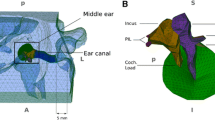Abstract
In modeling the propagation of signals produced in the cochlea, the effects of the middle ear must be included. We present a linear two-port network model of the middle ear of cat with air cavities open. Effects of the eardrum, ossicular chain, oval and round windows, and fluid in the vestibule are included. The two ports represented are: 1) the ear canal; and 2) the basal end of the cochlear spiral. The model parameters were selected to fit experimental data measuring various aspects of forward transmission only. However, we have used the model to reproduce acoustic distortion signals observed in the ear canal. Three significant findings are that: 1) The design of an acoustic coupler can have a large effect on signals measured in the ear canal; 2) The middle ear and acoustic coupler affect the reflection of distortion signals back into the cochlea and therefore affect distortion signals observed within the cochlea as well as in the ear canal; 3) The reverse transmission properties of the middle ear circuit model are highly frequency dependent.
Access this chapter
Tax calculation will be finalised at checkout
Purchases are for personal use only
Preview
Unable to display preview. Download preview PDF.
Similar content being viewed by others
References
Guinan, J.J., Jr. and Peake, W.T. (1967). Middle-Ear Characteristics of Anesthetized Cats, The Journal of the Acoustical Society of America, 41, 1237–1261.
Kemp, D.T. (1978). Stimulated acoustic emissions from within the human auditory system, The Journal of the Acoustical Society of America, 64, 1386–1391.
Kim, D.O. (1980). Cochlear mechanics: Implications of electrophysiological and acoustic observations, Hearing Research, 2, 297–317.
Kim, D.O., Molnar, C.E., and Matthews, J.W. (1980). Cochlear mechanics: Nonlinear behavior in two-tone responses as reflected in cochlear-nerve-fiber responses and in ear-canal sound pressure, The Journal of the Acoustical Society of America, 61, 1704–1721.
Lynch, T.J., III, Nedzelnitsky, V., and Peake, W.T. (1982). Input impedance of the cochlea of cat, The Journal of the Acoustical Society of America, 72, 108–130.
Matthews, J.W. (1980). Mechanical Modeling of Nonlinear Phenomena Observed in the Peripheral Auditory System. Doctoral dissertation, (Washington University, St. Louis, Missouri).
Matthews, J.W., Kim, D.O., Molnar, C.E., and Neely, S.T. (1981). Modeling reverse middle ear transmission: Aural acoustic distortion products, “echoes,” and spontaneous emissions, The Journal of the Acoustical Society of America, 69, S43, (A). Møller, A.R. (1963). Transfer Function of the Middle Ear, The Journal of the Acoustical Society of America, 35, 1526–1534.
Møller, A.R. (1963). Transfer Function of the Middle Ear, The Journal of the Acoustical Society of America, 35, 1526–1534.
Nedzelnitsky, V. (1980). Sound pressure in the basal turn of the cat cochlea, The Journal of the Acoustical Society of America, 6, 1676–1689.
Neely, S.T. (1981). Fourth-order Partition Mechanics for a Two-dimensional Cochlear Model. Doctoral dissertation, (Washington University, St. Louis, Missouri).
Peake, W.T. and Guinan, J.J., Jr. (1967). Circuit Model for the Cat’s Middle Ear, Massachusetts Institute of Technology Research Laboratory of Electronics Quarterly Progress Report, 84, 320–326.
Shaw, E.A.G. and Stinson, M.R. (1981). Network concepts and energy flow in the human middle-ear, The Journal of the Acoustical Society of America, 69, S43, (A).
Siegel, J.H., Kim, D.O., and Molnar, C.E. (1982). Effects of altering organ of Corti on cochlear distortion products f2-f1 and 2 f1-f2, Journal of Neurophysiology, 47, 303–328.
Zwicker, E. (1980). Cubic difference tone level and phase dependance on frequency difference and level of primaries. In: Psychophysical, Physiological and Behavioural Studies in Hearing, edited by G. van den Brink and F.A. Bilsen, (Delft University Press, Delft, The Netherlands), pp. 268–271.
Author information
Authors and Affiliations
Editor information
Editors and Affiliations
Rights and permissions
Copyright information
© 1983 Delft University Press, The Netherlands
About this paper
Cite this paper
Matthews, J.W. (1983). Modeling Reverse Middle Ear Transmission of Acoustic Distortion Signals. In: de Boer, E., Viergever, M.A. (eds) Mechanics of Hearing. Springer, Dordrecht. https://doi.org/10.1007/978-94-009-6911-7_2
Download citation
DOI: https://doi.org/10.1007/978-94-009-6911-7_2
Publisher Name: Springer, Dordrecht
Print ISBN: 978-94-009-6913-1
Online ISBN: 978-94-009-6911-7
eBook Packages: Springer Book Archive



